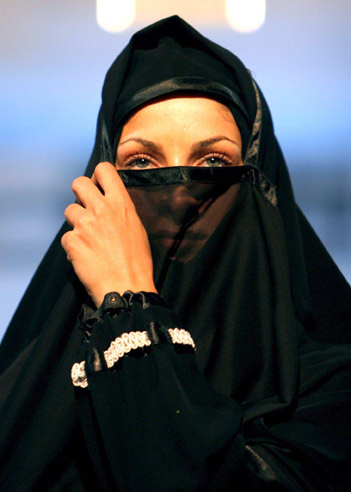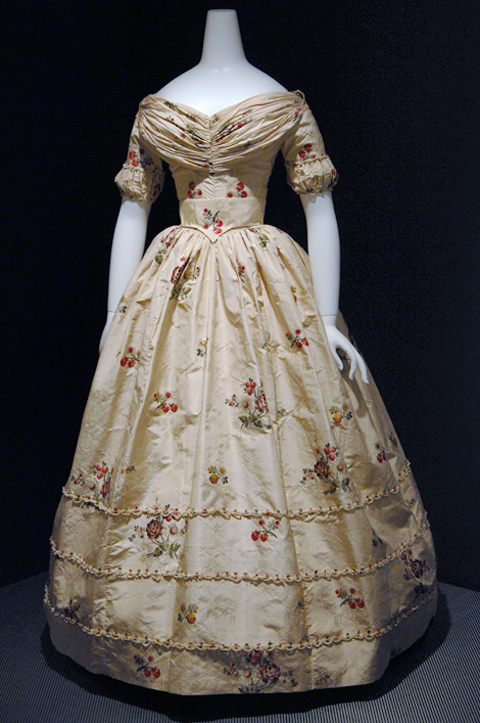I just read an article about rules being imposed upon models on Iranian catwalks by the Culture and Islamic Guidance Ministry:
“Move modestly. No garish makeup. Don loose and unrevealing clothing. Those are some of the new rules for Iranian models, who have been told not to attract too much attention during fashion shows.
Live models “should avoid any behavior that would distract visitors’ attention from the clothes put on display,” according to the eight-part “Guideline For Fashion And Dress Shows.”
Models are not allowed to show off the curves of their bodies, and their hair should not be seen,” the document reads. “The wearing of tight and body-hugging clothes and types of makeup that are incompatible with Islamic and Iranian culture are prohibited.”
Am I wrong, or isn’t the point of models to attract attention? They are walking display cases of fashionable goods. It’s revealing (haha) that they don’t ban the entire profession of modeling; instead they systematically ban every part of the job description. Also, these regulations are written as though they address models, but it is the designers who will have to make the largest adjustments, for it is not the model who decides how short the skirt is or how clingy a garment is. This is a transparently misguided attempt to stave off dirty Western influence from the unsullied reputations of Iran’s citizens.
A bullet point from the Ministry of Culture’s website:
“Conducting research works on the propaganda campaign of international media and becoming familiar with their techniques and the ways to counter their measures if needed.”
The root problem, as the Iranian government sees it, seems to be the perception that being exposed to– and heaven forbid, adopting– Western visual aesthetics is an assault upon the very foundation of Islam and its people.
In looking up the definition of hijab, I discovered that one of its root meanings is “to shelter,” which manages to sound protective and sweet. Not so darling are the alternate root definitions of “to cover” and “to screen,” which imply outright censorship. I find the idea of attempting to govern morality through uniforms — because that is essentially what the hijab is — absolutely laughable. You may be effectively covering sexual organs, but after all, uniforms are one of the most common fetishes. Though a primary function of a uniform is to identify a person as a member of a particular group, and often to convey asexual professionalism, the result is more often than not the very opposite of that intention. Everything from military and firemen uniforms to nun, priest, and Catholic school uniforms are firmly rooted in the fetish world, and have been for (at least) hundreds of years. This connection is not mere coincidence. Deny simple activities or pleasures, cloak bodies or processes in mystery, and the mystique surrounding those forbidden objects or activities will increase in direct proportion to the severity of the taboo.
I’m curious to hear other people’s take on this issue, please share!





























3 comments
Hijab says:
Jul 5, 2013
This might give you some understanding about Hijab. Note. Muslim women wears or pratcises hijab to please their Creator, Allah alone and no creation of Allah.
http://youtu.be/3w-1MP_IAj0
http://youtu.be/nJdp_1jIyKQ
http://youtu.be/ObFUB8shVOU
Tove Hermanson says:
Jul 8, 2013
Thank you for submitting these thoughtful videos. While I strongly agree that women should not be judged by their looks and should not be exploited by their male family members or their societies (women should control their own bodies inside and out)– which I hope I made clear in my original article– my conflicted relationship to the hijab lingers. Even when Western dress dictated more modest clothing than today’s styles– ankles were not exposed, parts of the arms were shown only after a certain time of day, bifurcated garments like pants were unthinkable, not to mention layers upon layers of underskirts to obscure the legs and genitals– women were *still* subjugated by men, excluded in politics and many aspects of political participation and even education. Covered up women conforming to contemporary signals of modesty did not make sexism disappear; it has been argued, in fact, that these dress regulations were an extension of patriarchal values and exertion of male power over women. I don’t necessarily believe that all Muslim men shame or force their female relatives and spouses into covering up, but I do sense that this is a (male dominated) societal pressure, and the fact remains that Muslim men aren’t expected to follow the same rules of modesty to prove their love for Allah.
The woman in the first video mentioned exploitation of women by pornography and sex, and the word “safe” came up as a reason to cover up in the third video, and this is precisely the murky ground where the interests of Allah and men become murky. Women *should* be safe. And pornography *can be* exploitative (though is not always). But matters of women’s safety should not be dependent upon women covering themselves up, because, no matter how lofty and religious the initial thinking, mortal men inevitably start to equate women’s morality as synonymous with– and dependent upon– these specific but limited visual cues of how women cover their bodies from them. Women who choose to flaunt their curves or their hair– which is our right too– begin to look like we’re “asking for it,” when in fact we are asking only to be treated like human beings who deserve the same rights of self-presentation and self *preservation* that women who choose to cover more of themselves desire, and which men often take for granted because of the lack of male body and clothing judgement and regulation.
Devon Welcher says:
Jun 24, 2011
Rather weird (in a good way ;)) blog. How can I subscribe to your site? Thank you. No hablo espanol!